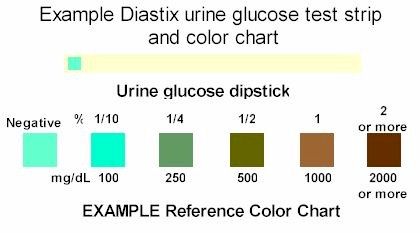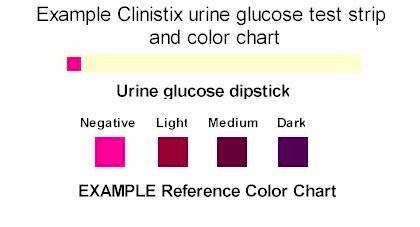|
|
How urine
glucose testing works
Many vets recommend urine glucose testing as a method of monitoring your pet's diabetes at
home. It is simple and inexpensive. But it has some serious limitations that must be
understood and taken into consideration.
Urine glucose testing is based on the fact that excessive amounts of glucose in the blood
will be filtered by the kidneys into the urine. Once the amount of glucose in the
blood exceeds the renal threshold (180 mg/dL) , glucose is spilled into the urine. The renal
threshold is the level at the kidneys can not "process" any more blood glucose
and it spills into the urine. If the blood glucose is high for an extended period of
time, glucose is usually present in the urine. The amount of glucose present in the
urine depends on how high the blood glucose was, and how long the blood glucose was high.
Urine glucose test strips like the pictures shown below are used. The test strip has
a little test area at the end that is dipped into urine or held in the urine stream. After
a certain amount of time, the color of the test area is compared to a reference color
chart. Bayer makes several types of urine tests strips. Diastix and Clinistix
test only for urine glucose. Keto-Diastix
test for both glucose and ketones. The Diastix have more "levels" of
glucose measurement than the Clinistix. Follow the instructions that come with your
test strips, and use the reference color chart on the bottle or box. The
picture shown below is just an example - the colors are NOT to be used to compare your
urine test strip. 

The color chart tells you approximately how much glucose has spilled
into your pet's urine.
Note: Different test strip brands use different numbers to
indicate the amount of glucose in the urine. When talking to your vet, it is
important that you are both thinking of the same value. For example a "1"
on one brand of strips may indicate very high urine glucose, while on another strip a
"1" is a low urine glucose. A "trace" amount usually refers to
the first non-negative color patch.
Here is a chart comparing the results you can obtain from Diastix, Keto-diastix, and
Clinistix.
Diastix
glucose |
(%) |
Negative |
1/10 |
1/4 |
1/2 |
1 |
2 |
| (mg/dL) |
Negative |
100 |
250 |
500 |
1000 |
2000
or more |
Keto-Diastix
Ketone |
(mg/dL) |
Negative |
5 |
15 |
40 |
80 |
160 |
Clinistix
glucose |
no units |
Negative
(pink) |
Light
(reddish) |
Medium
(maroon) |
Dark
(purple) |
might be
referred to as: |
negative |
1 |
2 |
3 |
Generally, urine testing is more useful in dogs than in cats. Several dog owners use
urine glucose testing to monitor their pet. Because it is usually more difficult to
obtain a urine sample from a cat, and cats often hold their urine a long time, it can be
very difficult to use urine glucose testing as an accurate method of determining the level
of regulation in a diabetic cat.
Accuracy
In the case where an animal isn't regulated, or is difficult to keep regulated, home urine
testing must be supplemented by some form of BG testing (either at home or at the vet). I
don't think urine testing is accurate enough and there's too much of a time lag between
the BG and the urine glucose levels for you to rely only on urine glucose levels to try to
achieve regulation.
The inaccuracies of urine testing will be exaggerated in animals that urinate
infrequently. This tends to be a problem with cats. The greater the amount of time
between urination, the more averaged the urine glucose will be. That batch of urine
was processed by the kidneys and collected in the bladder over a longer period of time.
Urine glucose tests may be more accurate on an animal that urinates frequently. In this
case, the urine is processed and eliminated over a shorter time and the urine glucose will
more closely reflect what the blood glucose levels were. Also, urine testing may be more
useful after the animal is regulated. Then you have a good idea that the bgs are within an
acceptable range, and the urine tests can be used to double check to see if glucose is
spilling into the urine.
Limitations of urine glucose
testing
The level of glucose in the urine is not the same as the level of glucose in the blood.
The urine level is just a reflection of how high the bg was, and how long it was
above the renal threshold (the point where glucose spills into the urine). There
will always be a difference between what shows up in the urine and what was actually in
the blood, and the urine glucose levels will always lag behind the blood glucose levels.
Also, urine test strips can not show if the bg
has ever gone too low. The strips are not designed to do
this.
Urine testing may be a method that you can use to monitor your pet's diabetes. But keep in
mind that urine testing has some serious limitations and may not work with your pet.
Our scary experience with
Barney
I thought a good way to explain the difficulties we had with urine testing was to describe
what happened with our cat Barney. Remember, each pet and circumstance is different,
but our experience with Barney shows that urine testing can be very ineffective, and
basing decisions about the insulin dose on just urine glucose test results can be
dangerous.
When Barney was first diagnosed, the vet told us to test his urine glucose at home.
We were instructed that if the urine tests were strongly positive for a few days, increase
the insulin by 1/2 unit. If the tests were negative for a few days, decrease insulin by
1/2 unit. If the tests were weakly positive, we were to keep the insulin dose the
same.
The vet also recommended that Barney come back for another day of bg testing. But I
had read several articles about stress induced high BG readings and decided not to have
the vet do BG testing. This is a very important factor in our situation. We did not have
any BG curves done after the initial diagnosis (BIG mistake). We relied solely on urine
glucose monitoring and behavioral observations such as urine volume, drinking, and
physical activity. In hindsight, we should have had at least one or two BG curves done
during this first 6 month period.
For the first 6 months, we seemed to have a lot of success in regulating Barney's diabetes
just by using urine testing. We gradually adjusted his insulin dose as indicated by the
urine test results. We started at 2 units once a day and were gradually up to 4.5 units
twice a day. During this time, we also had a fructosamine test done. This test shows the
average BG control over 2-3 week period. The results of this test were excellent. I still
wondered about the daily BG highs and lows, but I was fairly comfortable that we had his
diabetes adequately regulated.
But then his urine was always testing strongly positive again. By now, I had done a lot of
reading about diabetes and had learned a lot of new things. I knew it was important for us
to learn what his bg levels were throughout the day. I also worried about giving too
much insulin and if he was having a Somogyi rebound. A Somogyi
rebound can occur when too much insulin is given and causes the bg to go too low, then the
body responds by dumping large quantities of glucose from the liver into the blood.
Remember, we didn't have any information about what his blood glucose levels were. The
fructosamine test told us that his average BG control was good, but we didn't know the
highs, lows, or how long the insulin was lasting.
So, we got a home BG meter and tested him. Here's what happened. It shows how
inaccurate urine tests can be.
- 6 pm: Barney peed and the urine glucose test was strongly positive. I
assume he emptied his bladder.
- 6:30 pm: gave him his insulin
- 10 pm: tested BG. It was dangerously low (<40mg/dL).
- 10:30 pm: (just 30 minutes after the bg test) he peed and the urine
glucose test strip showed +2, lots of glucose in the urine.
So between 6 pm and 10:30 pm his BG dropped dangerously low, but the
urine that he processed during that time contained lots of glucose.
If I was giving insulin based only on the urine test, I would have increased his
insulin. This could have been a fatal mistake.
Barney's urine never tested negative for glucose even though his BG was very low for 2-3
hours of the day. The problem was that the amount of time that his BG was very low was too
short, and could not be detected by urine testing. For part of the day his BG was too low,
but for most of the day his BG was too high and lots of glucose always showed up in the
urine.
The ONLY way I figured this out was to do a BG curve. Or the vet could have done a
bg curve. But a bg curve had to be done.
A Little Humor
Taking care of a diabetic pet is stressful, and it's important to keep your spirits up.
Bobbi, our resident lyricist has written "Where's
The Dignity?". Maybe this is what your pet is thinking when he sees you get
out the urine test strips.
 




Updated October 2000
Copyright. All rights reserved.
This site is for information purposes only. Please consult
your veterinarian. |
 Urine Glucose
Testing
Urine Glucose
Testing Urine Glucose
Testing
Urine Glucose
Testing